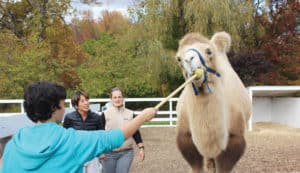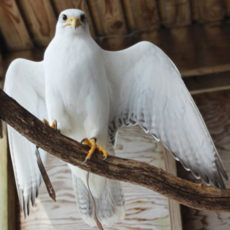Announcements

Green Chimneys Farm Education Manager Miyako Kinoshita and Social Worker Shauna McWilliams are colleagues and friends. Their closeness comes in handy when tackling the unexpected, in this case, partnering with camels Sage and Phoenix in animal-assisted therapy sessions for children with special needs.
 With over 30 years of combined experience working with children and animals, Miyako and Shauna have been leading student sessions incorporating the camels for over 2 years. The result: an understanding of how the camels can help children challenged by anxiety, attention deficits, and difficulties with emotional regulation to develop and make connections between the camels’ behavior and their own. It is their hope that these connections become generalized and translate to interactions that students face in school, as well as at home and in the community. We’re so grateful for the opportunity to partner with these noble creatures.
With over 30 years of combined experience working with children and animals, Miyako and Shauna have been leading student sessions incorporating the camels for over 2 years. The result: an understanding of how the camels can help children challenged by anxiety, attention deficits, and difficulties with emotional regulation to develop and make connections between the camels’ behavior and their own. It is their hope that these connections become generalized and translate to interactions that students face in school, as well as at home and in the community. We’re so grateful for the opportunity to partner with these noble creatures.
Most of the animals at Green Chimneys that participate in therapy sessions are very familiar species, and a comfort level is important in engaging the student in therapy. Camels are not the animals you see every day; they seem foreign, exotic, and somewhat intimidating. They are majestic so staff and students are attracted to them, and their uniqueness and size seem to draw students’ attention when they are with the camels so they are less likely to tune out. Students who tend to be overconfident with other animals are also humbled around the camels. The camels seem to have an ability to put us in our place, so to speak, with their size, their exotic look, and their powerful gaze.
Working with camels can be both exhilarating and intimidating, which can be a challenge for a student with anxiety. Therapy sessions with camels offer these students opportunities to be exposed to something that increases their anxiety in a safe environment with a therapist and an animal handler. Through repeated exposure, coupled with skills in emotional regulation and stress tolerance, they practice managing their anxiety and hopefully develop a sense of mastery over it.
Camels bring something different to the proverbial table as they aren’t trained the way horses or dogs are. The camels’ emotional nature – their mood, their curiosity or level of engagement – plays a large part in each session. Phoenix and Sage were raised to be motivated by engagement, by curiosity. There’s no moving a 1,500-pound animal with a halter; there’s a higher level of social connection they seek and respond to. This is what makes them excellent therapy partners, especially when working with children who need help in strengthening their social skills, confidence, and ability to stay connected and engaged in the moment. If the student is engaged and enthusiastic about the interaction, the camels will likely remain engaged. If the student loses focus, the camels will lose focus and they will quickly disengage. It requires a great deal of effort on the part of the student to keep the camels engaged through eye contact, conversation, and attending to the animal’s body language, which all impacts reinforcement of the social connection.
Because camels are emotional, Miyako, Shauna and the student often need to meet Sage and Phoenix first, then modify plans according to how the camels are reacting or behaving. Flexibility from staff and students, and sometimes from the camels, is required. Some of our students are rigid thinkers and they struggle with unpredictable changes during the school day. Camels are excellent in teaching students to be understanding, patient, and willing to come up with alternatives rather than trying to stay on one track. This process develops the student’s capacity for flexible thinking, as well as being able to let go of things that they have no control over. It presents them with the opportunity to realize and practice that there are many things in life that they have no control over. What they can control is how they respond to the situation. Are they going to choose to respond in a way that will make the situation better or worse? What do they want, and how can they negotiate with the camel to accomplish their goal?

Crowned the best for falconry in medieval times, gyrfalcons were once reserved for kings. As the largest falcon in the world, with exquisite plumage ranging from bright white to deep charcoal, gyrs are revered for their powerful skill of flight. Their long wings make hunting waterfowl from 3,000-feet-high a feasible and fantastical feat. This falcon was flown in the sport of falconry for several years.